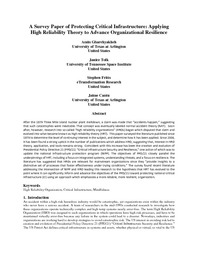
ATTENTION: The works hosted here are being migrated to a new repository that will consolidate resources, improve discoverability, and better show UTA's research impact on the global community. We will update authors as the migration progresses. Please see MavMatrix for more information.
Show simple item record
| dc.contributor.author | Gharehyakheh, Amin | |
| dc.contributor.author | Tolk, Janice N. | |
| dc.contributor.author | Cantu, Jaime | |
| dc.contributor.author | Fritts, Stephen | |
| dc.date.accessioned | 2018-11-09T20:51:06Z | |
| dc.date.available | 2018-11-09T20:51:06Z | |
| dc.date.issued | 2017 | |
| dc.identifier.citation | Published in IIE Annual Conference Proceedings | en_US |
| dc.identifier.uri | http://hdl.handle.net/10106/27580 | |
| dc.description.abstract | After the 1979 Three Mile Island nuclear plant meltdown, a claim was made that “accidents happen,” suggesting that such catastrophes were inevitable. That concept was eventually labeled normal accident theory (NAT). Soon after, however, research into so-called “high reliability organizations” (HROs) began which disputed that claim and evolved into what became known as high reliability theory (HRT). This paper surveyed the literature published since 1979 to determine the level of continuing interest in the subject, and determine how it has been applied. Since 2004, it has been found a strong uptick in the number of publications which address HRO, suggesting that, interest in HRO theory, application, and tools remains strong. Coincident with this increase has been the creation and evolution of Presidential Policy Directive 21 (PPD/21) “Critical Infrastructure Security and Resilience,” one action of which was to update the national infrastructure protection program (NIPP). The objectives of PPD/21 closely parallel the underpinnings of HRT, including a focus on integrated systems, understanding threats, and a focus on resilience. The literature has suggested that HROs are relevant for mainstream organizations since they “provide insights to a distinctive set of processes that foster effectiveness under trying conditions.” The survey found recent literature addressing the intersection of NIPP and HRO leading this research to the hypothesis that HRT has evolved to the point where it can significantly inform and advance the objectives of the PPD/21 toward protecting national critical infrastructure (CI) using an approach which emphasizes a more reliable, more resilient, organization. | en_US |
| dc.description.sponsorship | IISE owns the copyright to this publication. | en_US |
| dc.language.iso | en_US | en_US |
| dc.publisher | Institute of Industrial and Systems Engineers (IISE) | en_US |
| dc.subject | High Reliability Organizations | en_US |
| dc.subject | Critical Infrastructure | en_US |
| dc.subject | Mindfulness | en_US |
| dc.title | A Survey Paper of Protecting Critical Infrastructure: Applying High Reliability Theory to Advance Organizational Resilience | en_US |
| dc.type | Article | en_US |
Files in this item
- Name:
- ASurveyPaperofProtectingCritic ...
- Size:
- 452.4Kb
- Format:
- PDF
This item appears in the following Collection(s)
Show simple item record


